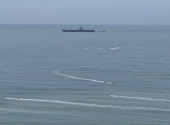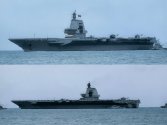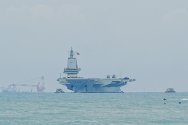Rumor has it J-15 will be transfer to academy use. J-15T will become inter-useable on both STO and CAT platformNot likely.
Shandong is an operational STO platform.
Fujian is a CAT platform that has not been commisioned, let alone achieved IOC.
J-15 cannot take off from a CAT.
J-15T pilots are not trained for Ski ramps.
So cross-decking exercise cannot happen.
KJ-500 are not operational yet. So cannot lead air wing exercises
I have no idea of the J-15T pilots work up but I doubt they are ready to participate in exercises led by Shandong either.
So no air wing joint exercises either.
Beyond that, what other joint exercise can they meaningfully participate in? Sailing as a combined CSG+ formation?
Also, pulling out a jointEx on such short notice, even if you have a drawer plan ready, without a workup period typically never happens.
You are using an out of date browser. It may not display this or other websites correctly.
You should upgrade or use an alternative browser.
You should upgrade or use an alternative browser.
CV-18 Fujian/003 CATOBAR carrier thread
- Thread starter Jeff Head
- Start date
No worries. Just a clarification of what "initial" might mean, not just with you but with multiple posters prior to your post.
I get that the airframe count for J-15 is already past that, probably in anticipation of populating Fujian. I also get that the pilot:airframe ratio is also higher than 1:1 - but the actual billets on Liaoning/Shandong are limited - hence the comment that the pool to draw from is highly limited without degrading the capabilities of 2 mature units.
I think what you are talking about raises a question about the readiness and role of CV-16/17 in peacetime in the last few years.
My perception is that CV-16/17 has been focused on two primary roles:
- maximizing mission availability
- its primary mission in these recent years has been mostly to maximize train cadres of pilots as well as provide training opportunities for supporting escort ships to operate in an experienced CSG manner, while having less focus on actual long range and long duration deployments (they do these every now and then to ensure the ship is capable of doing so, but it is not a primary focus)
All of which is to say, CV-16/17 in these recent years are fully combat capable carriers that I suspect have been focusing on generating as many experienced naval aviators, carrier crew, and experienced surface combatant crews for CSG work, as practically possible, to develop capacity -- with a secondary focus being going on frequent long range or long duration deployments.
All of which is a long way of saying, I suspect the current/recent existing J-15/T pilot cadre is probably already disproportionately oversized for what would be needed for CV-16/17 if they were doing "regular frontline combat duties" most of the time (which for the last few years they've spent most of their time doing training and working up as many pilots and crews as possible, while only occasionally doing frontline combat duty/patrols).
While the Fujian is undergoing testing and the actual airframes and pilots on board are very limited, it also stands to reason that the future airwings have already been stood up and doing land-based workup training, readying themselves for deployment onto Fujian once commisioned(?). So the requirements for those pilots is very here and now and is probably part of the reason for the high airframe count for J-15s beyond attrition replacements and rotation - hence again, the difficulty of pulling experienced pilots from currrent population without affecting current capabilities.
You are talking about future pilots that will embark upon CV-18. I have already agreed and said that those pilots would likely not need to be drawn from existing J-15/T drivers.
The future airwings for J-35 and KJ-600s you speak of, have likely yet to even be fully physically produced yet.
Meanwhile myself and others have been talking about the imminent pilots for CV-18's initial airwing when it first enters service, and those would most likely be drawn from existing J-15/T drivers.
I'm talking about the literal first 8-12 J-35s and 8-12 J-15Ts and 3-4 KJ-600s that will form part of CV-18s first ever regular fixed wing implement in service, and the pilots who will fly those airframes.
It is those pilots who I expect to be drawn from experienced J-15/T pilots. After that, for maybe a year or two of gradual airframe expansion and developing more pilot experience and more pilot capacity, I expect them to transition to freshly trained pilots for J-35 and KJ-600.
I think what you are talking about raises a question about the readiness and role of CV-16/17 in peacetime in the last few years.
My perception is that CV-16/17 has been focused on two primary roles:
- maximizing mission availability
- its primary mission in these recent years has been mostly to maximize train cadres of pilots as well as provide training opportunities for supporting escort ships to operate in an experienced CSG manner, while having less focus on actual long range and long duration deployments (they do these every now and then to ensure the ship is capable of doing so, but it is not a primary focus)
All of which is to say, CV-16/17 in these recent years are fully combat capable carriers that I suspect have been focusing on generating as many experienced naval aviators, carrier crew, and experienced surface combatant crews for CSG work, as practically possible, to develop capacity -- with a secondary focus being going on frequent long range or long duration deployments.
I have the same view that CV-16/17 has been dual-roleing between being a mission capable ship of the PLAN and also very much a "training" ship for developing CONOPs and training of crew. If anything, I would say the same of Fujian and the next hull and likewise the first CVN (if the next hull is conventional) will all likewise largely for developing CONOPs and a broad base of expertise for the leap into genuine blue water force projection much much further down the road.
Meantime, CV-16/17 while fully combat capable, my observation is that they have hardly been long range or long duration deployment - "long" being compared to the yardstick of USN or even CV QE (28 weeks).
Which is something I'm curious about then, given your comment that J-15/T pilot cadre is "probably disproportionately oversized". As I've mentioned, there are limited billets available on CV-17/18 - one can only squeeze that many J-15/T onto a CV, about 24 max? There are only 2 such CVs. Constantly rotating otherwise superfluous personnel into and out of a operational unit is not conducive to maintaining capabilities. How would one then ensure actual cohesiveness and currency of skills/capabilities?
Does CV-17/18 operate a Blue/Gold crew given it's relatively frequent but short(er) duration deployments?
I have the same view that CV-16/17 has been dual-roleing between being a mission capable ship of the PLAN and also very much a "training" ship for developing CONOPs and training of crew. If anything, I would say the same of Fujian and the next hull and likewise the first CVN (if the next hull is conventional) will all likewise largely for developing CONOPs and a broad base of expertise for the leap into genuine blue water force projection much much further down the road.
Meantime, CV-16/17 while fully combat capable, my observation is that they have hardly been long range or long duration deployment - "long" being compared to the yardstick of USN or even CV QE (28 weeks).
Which is something I'm curious about then, given your comment that J-15/T pilot cadre is "probably disproportionately oversized". As I've mentioned, there are limited billets available on CV-17/18 - one can only squeeze that many J-15/T onto a CV, about 24 max? There are only 2 such CVs. Constantly rotating otherwise superfluous personnel into and out of a operational unit is not conducive to maintaining capabilities. How would one then ensure actual cohesiveness and currency of skills/capabilities?
Does CV-17/18 operate a Blue/Gold crew given it's relatively frequent but short(er) duration deployments?
There are multiple ways to skin that particular cat.
Blue/Gold crewing would be one of them.
Another could be to recognize that there are certain key skills which are more important than others for developing capacity aka developing large capacity of experienced pilots, crew, personnel.
- For example for a pilot, key competencies like carrier qualifications, and having sufficient time aboard a boat, working with deck crew etc, are probably things that you need to spend time aboard a carrier for.
- However, other key competencies such as carrying out the full variety of sorties over water, joint operations with friendly naval forces/escorts, etc, probably doesn't need to be specifically done where the pilot has to take off from a carrier because those are things which don't really matter if you've taken off from a carrier or from land so long as you are flying over water. (Of course certain things like endurance over water, distance etc would be things that you can't simulate, but there are still ways to account for those effects if you're taking off from land).
- Then there are certain characteristics/experiences which might not be essential for your pilots, such as spending months and months at sea on long deployments, which are going to be useful for psychological and personnel resilience on long deployments, but that may be something that is just deemed as a worthwhile omission if the tradeoff is the ability to train more pilots
- Lastly, there are certain characteristics/experiences which are essential/vital for your pilots that cannot be simulated on land and which need to be trialled and developed, such as occasional large scale, open ocean CSG deployments to simulate a high intensity operation in a full or near-full "dress rehearsal". In such a scenario, of course as you've written, CV-16/17 can only carry 24 J-15/Ts each, meaning only a fraction of pilots at any one time will be able to experience such training... and that would again likely be deemed an acceptable tradeoff if they are able to train more pilots, and they will likely seek to milk those exercises for as much as they are worth, and the pilots who do get the opportunity to embark on that sort of training will likely have a dedicated pipeline to share as much of the lessons and wisdom from those exercises with their colleagues as possible.
And rinse and repeat for every other carrier specific crew/ personnel.
I have the same view that CV-16/17 has been dual-roleing between being a mission capable ship of the PLAN and also very much a "training" ship for developing CONOPs and training of crew. If anything, I would say the same of Fujian and the next hull and likewise the first CVN (if the next hull is conventional) will all likewise largely for developing CONOPs and a broad base of expertise for the leap into genuine blue water force projection much much further down the road.
Meantime, CV-16/17 while fully combat capable, my observation is that they have hardly been long range or long duration deployment - "long" being compared to the yardstick of USN or even CV QE (28 weeks).
Which is something I'm curious about then, given your comment that J-15/T pilot cadre is "probably disproportionately oversized". As I've mentioned, there are limited billets available on CV-17/18 - one can only squeeze that many J-15/T onto a CV, about 24 max? There are only 2 such CVs. Constantly rotating otherwise superfluous personnel into and out of a operational unit is not conducive to maintaining capabilities. How would one then ensure actual cohesiveness and currency of skills/capabilities?
Does CV-17/18 operate a Blue/Gold crew given it's relatively frequent but short(er) duration deployments?
I recall that ships in the Chinese Navy are deliberately and permanently overmanned by 25%, in anticipation of needing trained personnel for new ship construction. So I wouldn't expect "superfluous" personnel to be constantly rotating in and out. Remember that the Chinese Navy mainly operates in the Western Pacific and generally keeps missions on the shorter side. So overcrowding should be tolerable.
A similar logic would also apply to the carrier airwing.
With aircraft, there are always more pilots than aircraft anyway. So adding even more pilots should be straightforward, and they'll be a permanent part of the airwing for at least 2 years, because new carriers don't come along that often.
They just use the existing aircraft more frequently.
Remember that wartime surge sortie rates are far higher than what is required for peacetime training, even if you doubled the number of pilots
According to a PLAAF friend of mine all carrier pilots are elites of elites.As mack8 wrote, there would be no reason for new pilots for CV-18 to be freshly trained pilots without any prior experience aboard carriers.
If anything it should be the default expectation, given how cautious the PLAN are, that they would seek to have some (at minimum) moderately experienced pilots make up CV-18's initial fixed wing air complement for all the aircraft types they embark.
And given that the only aircraft type that pilots would have experience on carrier deck operations for CV-16/17 are J-15 and J-15T family aircraft, it would naturally follow that the J-35 and KJ-600 pilots would likely have had J-15/T experience as well.
At some point, once the training pipeline for new aircraft types and pilot community/cadres becomes more established, then J-35 and KJ-600 pilots would likely have their own training path rather than being initially J-15/T pilots.




